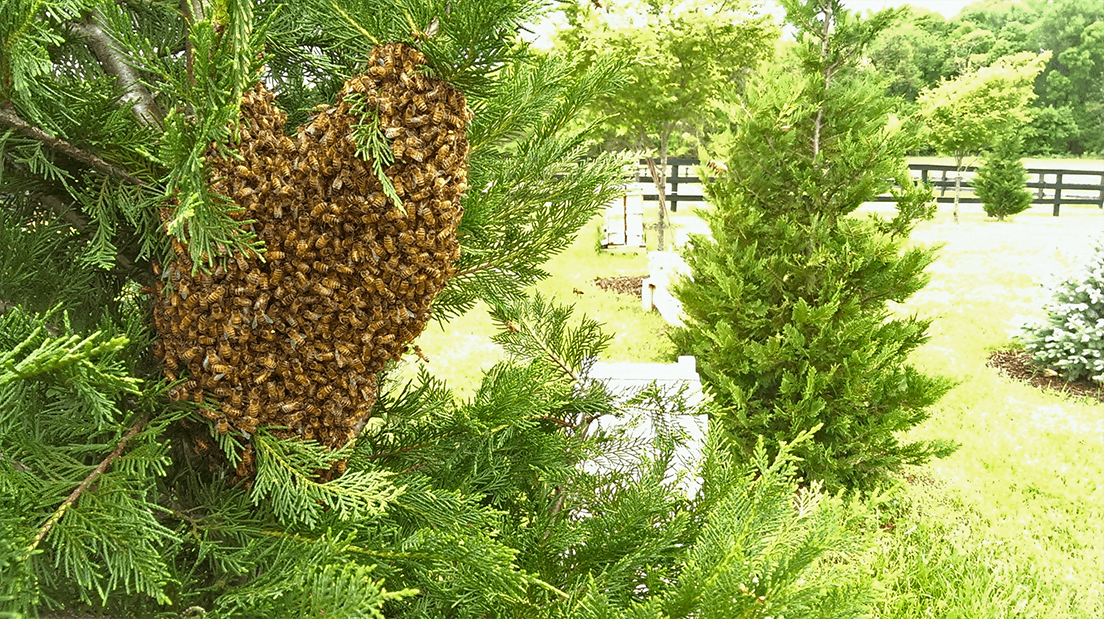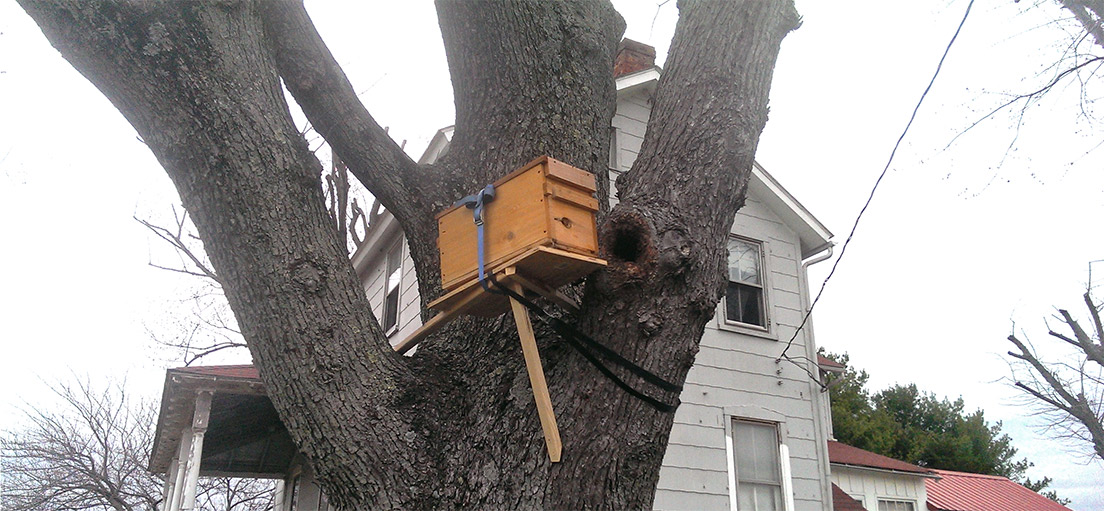It’s Honey Bee Swarm Time in Loudoun County
In my book, the spring is marked by the first phone call of the year requesting that I come catch a honey bee swarm or remove bees from an old tree or building. Yesterday I received my first call of the season. It must be spring!

To be fair, it’s not quite spring yet. Yesterday’s call was in preparation to extract a colony of bees from an old rotting tree once the weather warms up a bit. The property owner is preparing for spring and wants to wait until the bees are again active, which is a good plan, as it will greatly increase the colony’s chance of survival to remove them when the weather isn’t so cold.
When spring is in full swing, I often get multiple calls a day to remove honey bee swarms in Leesburg and Loudoun county. One of the fun aspects of catching and removing swarms is being able to educate people about bees and swarms. Here are some of the frequently asked questions about honey bee swarms that I hear:
What is a honey bee swarm?
A colony of bees is a super-organism headed by a single queen. Like a cell in your body the colony grows until it is large enough to split in two. When it reaches that point it will raise a second queen so both sides of the split will have one. Just before the new queen hatches, the old queen along with about half of the colony’s bees set out to find a new home. Initially they don’t go far. They may go only a few feet, or they may go a bit further, perhaps 50 yards or so, where they will then form a large clustered ball in a bush or hanging from a tree branch.
From this stopover point they will send out scouts to look for a new home. Once the scouts locate and notify the cluster that they have located an ideal homesite, all at once the bees will fly (swarm) to the new location. This intermediate stopover in a bush or on a branch may be as short as an hour, or may last up to a day or two. While they are clustered like this the bees are generally very calm and docile. It’s the perfect time to catch the swarm.
How do you catch a swarm of honey bees?
Catching a swarm as described above is a simple as slipping a deep bucket under the ball of bees and giving the branch a quick shake to drop the bees into the bucket. To form the ball the bees are all holding onto each other and as such, are not ready to fly. When you shake the branch they fall right into the bucket. Of course, in real life it is rarely this simple as the bees may be high up in a tree, they may be in a dense bush and span many small branches in, or be spread out across a wall or fence. Plus once you have the bees it’s important to immediately transferred them to a suitable home so that they don’t overheat and die in the container they were caught in (yes, they do create a lot of heat).
Who should I call for swarm removal?
A beekeeper, not a pest removal company. With dwindling resources, pesticides, and disease, honey bees are under a great deal of stress. The more colonies we can keep alive the better.
I suggest that you google your local county beekeeper association. For Loudoun county swarm removal, I would suggest you contact someone from the the Loudoun County Beekeepers Association swarm removal list. You will find me there, or you can just text me at 703.867.4337.
How do I know if what I have is a honey bee swarm?
Honey bees are the only insects that swarm and create clusters as described and shown above. Solitary bees, wasps, hornets, and the like do not have the same super-organism social structure and do not swarm like honey bees do. If you come across what you think may be a swarm of bees but are unsure, take a photo and text it to your local beekeeper – they should be able to confirm it for you.
Where will the honey bee swarm find a home?
Honey Bees like enclosed structures with a volume roughly equal to one to two five gallon buckets, with a single small entrance. I imagine that more often than not the swarm will go unnoticed, will not be caught, and will be successful in finding a new home. Ideally it will be in the hollow of an old tree, around 15 feet off the ground, at the edge of the forest but quite often, in urban and suburban areas, it is in the wall of a house or some other equally inconvenient location.
How do you remove honey bees from a house?
There are essentially two methods to remove bees from a structure.
- A cut-out
- A trap-out
A cut-out is just as the name implies – the person doing the removal cuts into the structure exposing the honey bee colony and then removes the bees, brood, comb, and honey. It’s quick but invasive. It can be quite destructive to both the structure (be it a building or tree) and the colony. It can also be expensive as not only do you have to cover the cost of the beekeeper, there will be a cost for the contractor to put things back together. If you are considering having this done to your home or business, be sure the person doing the work is a licensed and bonded building contractor.
A trap-out on the other hand is gentle, completely non-invasive, but it takes time (about six weeks) to complete. A bait hive is provisioned with comb and fresh bee eggs (yes, they start life as eggs) and placed within a few inches of the entrance of the original colony. A one-way passage is placed over the entrance of the original colony so the bees can get out but not back in. Needing a place to live and unable to return to their original home they enter the bait hive and care for the young bees to be that have been placed there. Once all of the bees in the original colony have hatched, grown up, and exited the colony, the bait hive is removed and the entrance to the old colony is blocked off so that no new colonies can move in.

